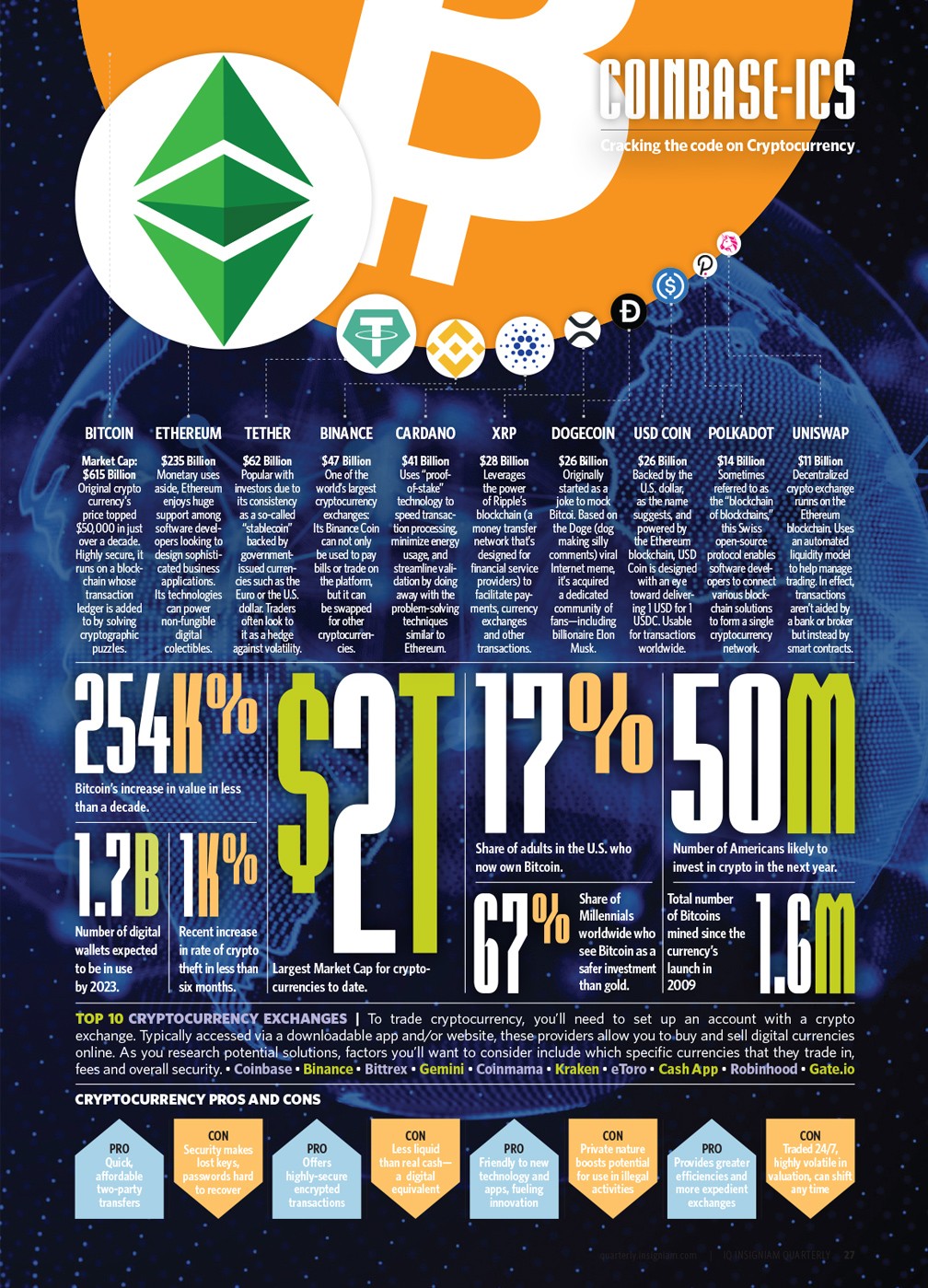Cryptocurrency 101: Cracking the Code on Crypto
With more than 10,000 types of cryptocurrency now available even as the market recently topped $2 trillion in value, it can be difficult to pick preferred options. Can’t tell a Litecoin from a Polkadot? Join the club: With more than one in three cryptocurrency investors equally perplexed, although 46 million Americans already own at least a share of Bitcoin, you’re in good company. This Cryptocurrency 101 guide will help you crack the code.
Cryptocurrency is a heavily encrypted form of digital asset. It’s powered by and traded over a decentralized network of computers that maintain closely tracked ledgers of transactions known as blockchain technology, thereby providing added privacy and security. These virtual currencies — which are not issued by a central authority such as a government, and are therefore heavily resistant to third-party manipulation — are enjoying ever-increasing popularity due to their privacy, speed and resistance to outside compromise. Experts expect them to continue revolutionizing the field of digital finance over the coming decade.
To make things simpler, here’s a cheat sheet for the wild world of crypto — a Cryptocurrency 101 of sorts in how you can make this new technology add up to serious results for your business.
Coins vs. Altcoins vs. Tokens
Here’s the first lesson in Cryptocurrency 101: Three different types of digital currency commonly fall under the heading of cryptocurrency: coins, alternative cryptocurrency coins (altcoins) and tokens. These are primarily differentiated by the underlying technology that powers each one and the specific use case that each of these currencies is designed to support.
Coins – Cryptocurrencies built with monetary transactions and trades in mind (e.g., Bitcoin) are generally referred to as coins because they’re intended to facilitate payment or the transfer of value.
Altcoins – These are cryptocurrencies that come with their own blockchain attached. The term refers to forms of crypto that came after Bitcoin, the original cryptocurrency (i.e., all alternatives to it, such as Litecoin), and/or those that represent variants to or improvements upon Bitcoin’s underlying open source blockchain software (e.g., Ethereum or Bitcoin Cash).
Tokens – These are built on top of another blockchain, and — although technically exchangeable or tradable assets in nature (able to take the form of customer loyalty points, airline credits, etc.) — they aren’t actual monetary currencies. For example, many applications piggyback on the blockchain that powers Ethereum to create and manage tokens that are designed for use with their software.

How Cryptocurrency Trading Differs From Trading Stocks
Unlike stocks, which bestow ownership of shares of a company upon purchase (and possible voting rights, recompense on bankruptcy, etc.), cryptocurrencies only grant you ownership of a virtual coin or token — a critical Cryptocurrency 101 tip. Purchase one, and you’re effectively trading a single form of currency — real-world or otherwise — for these digital assets.
Capable of being traded 24/7, though, unlike stocks (generally traded weekdays for a seven-hour period), cryptocurrency is also largely unregulated. In other words, a governing body does not verify crypto providers’ credentials, and much financial information surrounding them remains private.
While investing in stocks or in cryptocurrency is an exercise in risk and can generate unpredictable results, stock investments tend to rise and fall based on company performance. By contrast, cryptocurrency prices — which can be hugely volatile — are often extremely speculative in nature and can be influenced by something as seemingly innocuous as one of Mr. Musk’s tweets.
Cryptocurrency is typically purchased through a crypto exchange, such as Coinbase, though some brokerages such as Robinhood may allow users to purchase through their systems. For tax purposes, cryptocurrency is often treated in similar fashion as a capital asset (e.g., stocks) versus cash, and subject to capital gains tax on the sale of these assets. In other words, make more on the sale of cryptocurrency than you paid for it and you’ll owe taxes on any remaining difference.
Top 5 Industries That Accept Crypto Payments or Offer Crypto ATMs
- Quick-service and casual restaurants
- Hospitality and accommodations
- IT services
- Convenience stores and gas stations
- Cafes and coffee shops
Predictably Unpredictable
Uncertainty is the only certainty when it comes to cryptocurrency, given the nature of these highly speculative investments and ongoing market volatility. “Stablecoins” (whose value is tied to another asset class, such as gold and government-issued fiat currencies, in order to stabilize price) offer investors a shelter against price fluctuation. Add to your Cryptocurrency 101 notes these sample options that offer exposure to crypto with an eye to minimizing risk :
- Tether
- Diem
- USD Coin
- Binance USD
- Dai
Key Takeaways
Cryptocurrency has revolutionized the world of finance and investment in just over a decade. Thanks to a steady flow of new technologies and market entrants, the industry continues to evolve at a blistering clip. Embraced by the world’s largest businesses and the general public alike, its footprint is rapidly expanding, and underlying high-tech DNA is quickly finding its way into a host of new distributed and networked applications. Here are some Cryptocurrency 101 lessons that business leaders can take from the rise (and occasional roller coaster-like dip in price) of the crypto market:
- Innovation is often as much about user experience and convenience as new technology.
- Ease of use, speed and accessibility can be sources of competitive advantage.
- Constant reinvention and experimentation are vital to maintaining growth.
- Both evolutionary change and revolutionary change can power winning results in business.
- Strategic partnerships can help you quickly scale your efforts to grow and advance in the marketplace.
- Making complex topics simple and actively providing public education is important to driving new technology adoption.
- Leveraging preexisting solutions and piggybacking on trending business needs can help you cut costs and accelerate growth.



